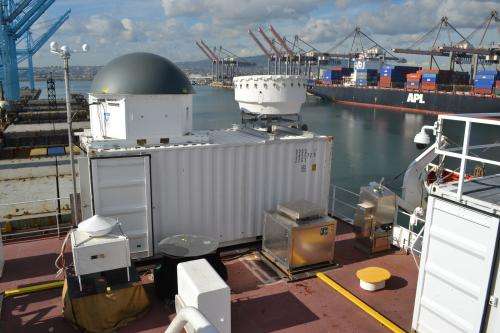Hawaii-bound in search of global climate data

While the idea of a cruise to Hawaii may sound like paradise, making that same journey 25 times back and forth in a year might start to lose its appeal.
But for a climate data-gathering machine called AMF2, perched aboard the ship, every trip is a chance to gather more data that is critical to understanding the Pacific Ocean's role in the global climate.
The machine is the Department of Energy's second Atmospheric Radiation Measurement (ARM) mobile facility, operated and managed by Argonne scientists. It carries a suite of instruments to measure properties of clouds, the ocean, precipitation, aerosols, and radiation. Over the summer of 2013, the AMF2 traveled back and forth between Hawaii and Los Angeles, taking data aboard the Horizon Spirit in the first official ARM marine deployment of its kind.
The AMF2's mission is to capture data so that scientists can get a better picture of the way that clouds, aerosols—particles in the air, like dust or smog—and Earth's energy and water balance interact over the Pacific. All of these variables are important in piecing together how the Earth's climate works as a whole.
AMF2 is particularly well-adapted to gather data in regions of the world that don't have much data yet, or are difficult to get to—like the open ocean.
Led by AMF2 operations manager Nicki Hickmon, the AMF2 team spent months adapting the instruments—which had been last deployed on land in the Maldives—to life aboard a ship. For example, they have to stay stable despite the rolling of the ship's deck as it plies the waves. (Feeling seasick yet?) The researchers installed special tables to correct for the motion.
Collecting data on atmospheric conditions over an entire year, including the transitions among cloud types along this particular route, will provide an enormous amount of new data to help refine and validate models of Earth's climate.
The mission is called MAGIC, which stands for the Marine ARM GPCI Investigation of Clouds; GPCI is a project comparing results from the major climate models. MAGIC is a collaborative effort involving Argonne and Brookhaven National Laboratory, as well as the Department of Energy, ARM, and others. The data will be made available to the scientific community through the ARM data archive located at Oak Ridge National Laboratory.
Provided by Argonne National Laboratory

















